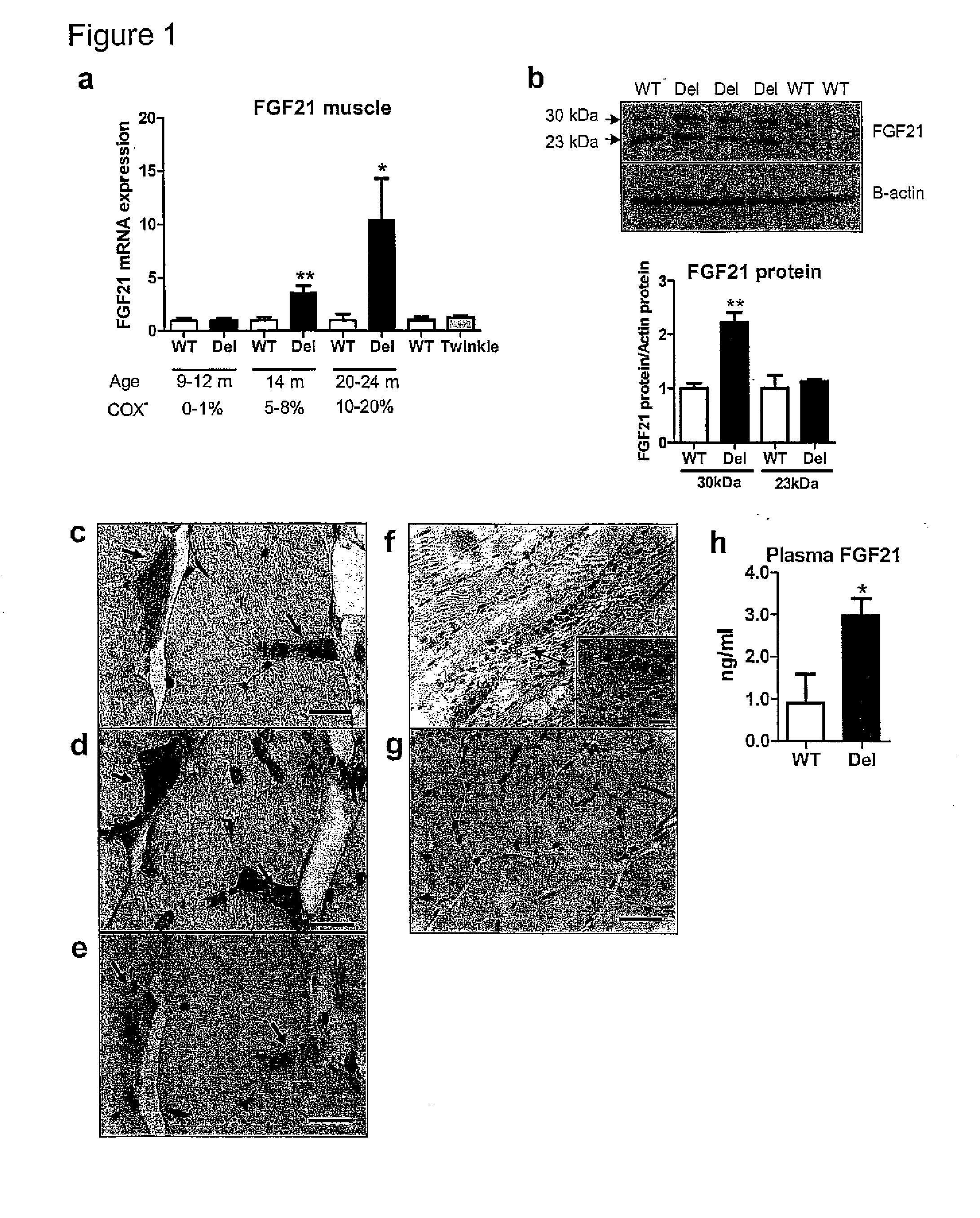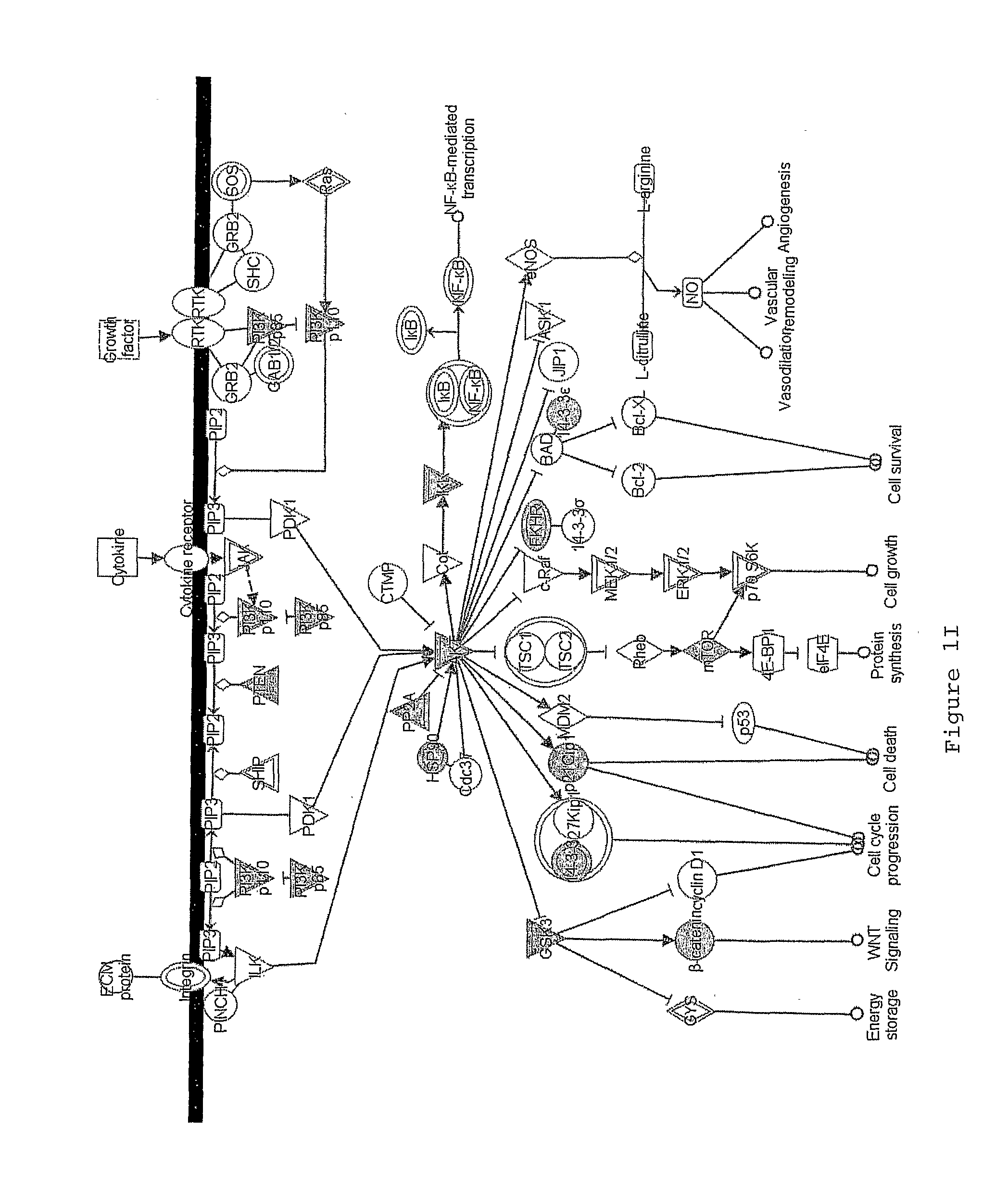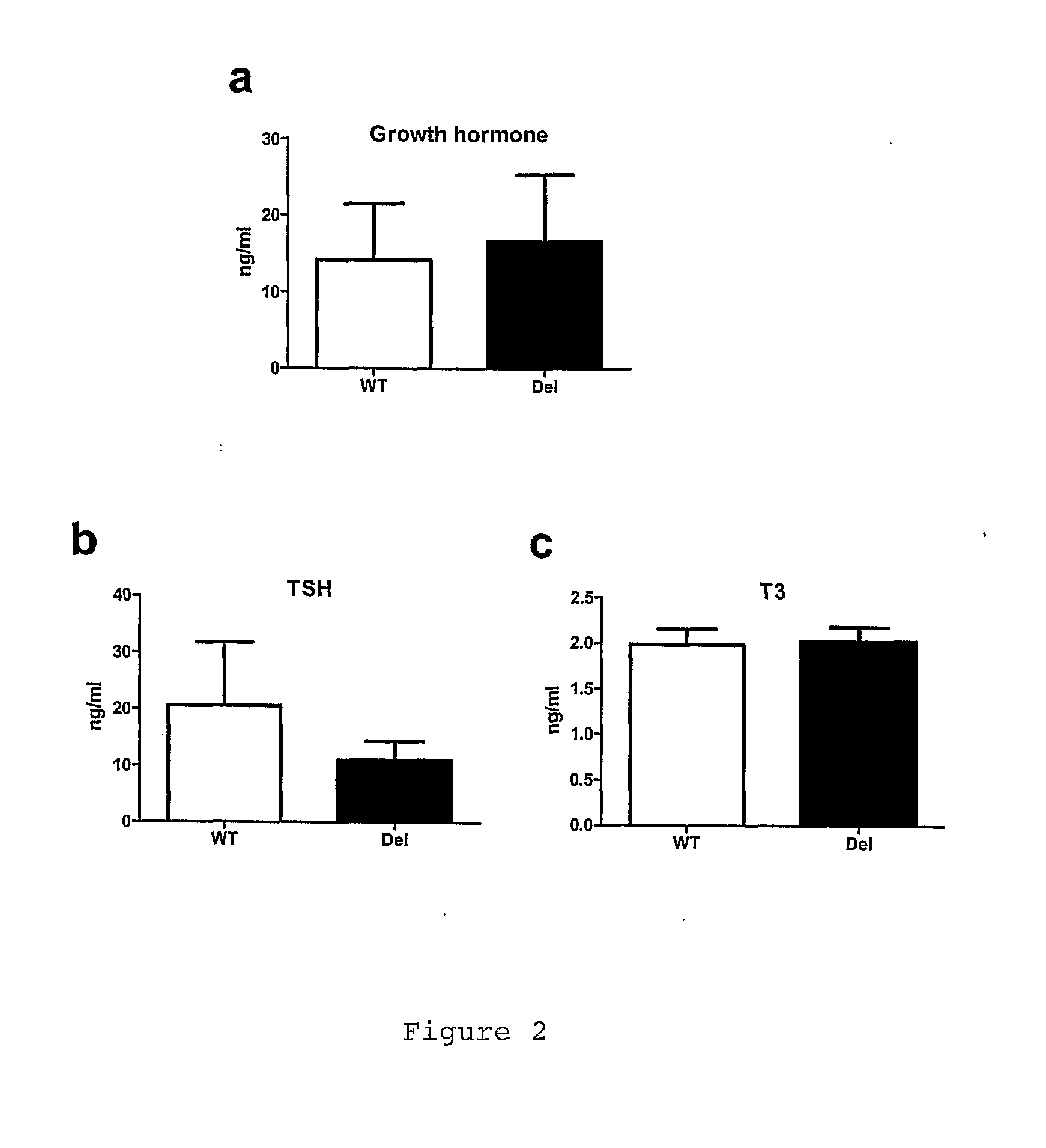[0038]According to a preferable embodiment of the method, the extent of the decrease in said concentration of FGF21 as compared to the concentration at earlier time point correlates with the effectiveness of the treatment.
[0047]Previously, transgenic hepatic over-expression of FGF21 in mice resulted in elevated
plasma FGF21 concentrations, and at 9 months of age these mice weighed significantly less, had less fat in liver, had adipocytes of smaller size and were resistant to high-
fat diet induced
obesity (Kharitonenkov et al., 2005). As these consequences are consistently observed in animals following FGF21 administration (Kharitonenkov and Shanafelt, 2008), the inventors studied whether the
skeletal muscle-derived FGF21 had the same
metabolic effects. Indeed, the Deletors had a smaller
adipocyte size compared to age-
matched control mice (50% reduction in D line, P=0.03; 36% reduction in C line, P=0.13) (FIGS. 4A and 4B), which was not due to qualitative or quantitative defects in mtDNA of
white adipose tissue (analyzed by quantitative and deletion-specific PCR, data not shown). The livers of Deletors showed a clearly reduced amount of lipid droplets (FIG. 4C), also suggesting utilization of lipids. If RC deficiency was indeed misinterpreted as starvation in
skeletal muscle, FGF21
signal could possibly be compensated by excess
nutrition. Therefore the inventors gave the Deletors and their control littermates a high-fat (HF) diet from the age of 3 months to 14 months. The food-consumption and the stool lipid-content of the Deletors was similar to controls (data not shown), but they were resistant to weight-
gain (FIG. 4D). HF-fed Deletors showed lower muscle FGF21 expression than Deletors on
normal diet (FIG. 4E, P=0.02), but the levels remained high compared to those of wild-type mice. Excess calories could thus partially compensate the RC-induced starvation
signal. All these findings are consistent with a global effect of muscle-derived FGF21 on
lipid metabolism, closely mimicking the consequences of liver-specific FGF21 overexpression. FGF21 has been proposed to be a potent
insulin sensitizer (Kharitonenkov and Shanafelt, 2008; Kharitonenkov et al., 2007), to cause
growth hormone resistance in mice, leading to
growth inhibition and elevated
growth hormone levels (Inagaki et al., 2008), as well as to reduce the circulating levels of
thyroid hormones in
obese mice (Coskun et al., 2008). However, in the mice used by the inventors, skeletal muscle-derived FGF21 in the serum did not cause significant alterations in fasted
insulin levels, or in the glucose or
insulin tolerance of the Deletors compared to control littermates (FIGS. 4F, 4G and 4H). Furthermore,
growth hormone levels as well as serum TSH and T3 levels of the Deletors were not significantly different from those of wild-type littermates (FIG. 2).Muscular FGF21 is not Induced in Transient Depletion of Energy Stores
[0051]Importantly, detection of serum FGF21 in human patients offers a novel
diagnostic biomarker. Currently, invasive skeletal muscle
biopsy is the golden standard when mitochondrial
myopathy is suspected in a patient, and patients may undergo several muscle samplings upon
disease progression. The results obtained by the inventors suggest that FGF21 levels could be measured as a first-line diagnostic
blood test, as well as for follow-up of
disease progression. FGF21 is a valuable novel new tool for less-invasive
mitochondrial disease diagnosis.
[0054]The only
physiological function of FGF21 known to date is to regulate the metabolic
adaptation to fasting. Upon limited
nutrition, FGF21 is secreted to the circulation by the liver or
adipose tissue, and it induces
lipolysis in the
adipose tissue and
ketone body production in the liver of mice (Badman et al., 2007; Inagaki et al., 2007). Sustained FGF21 over-expression resulted in growth
hormone resistance (Inagaki et al., 2008). FGF21 has been suggested to be an attractive therapeutic agent for type-2 diabetes, because it lowered efficiently glucose and lipid levels in an insulin-independent manner when administered in diabetic mice and monkeys (Kharitonenkov et al., 2005; Kharitonenkov et al., 2007). Furthermore, FGF21 corrected
obesity in mice (Coskun et al., 2008; Xu et al., 2008). The inventors show here that muscle-derived FGF21 induction in RC deficiency replicated all the known global consequences of FGF21 on
lipid metabolism, but did not affect growth
hormone, insulin or
thyroid hormone levels, or insulin or
glucose sensitivity. These hormonal effects were, however, seen in mice over-expressing the
protein, or after administration of recombinant FGF21, leading to high FGF21
plasma concentrations: liver-specific FGF21 over-expressor mice had 50-170 ng / ml (Kharitonenkov et al., 2005) or >20 ng / ml (Inagaki et al., 2008) of FGF21 in
plasma, whereas the Deletors had ˜3 ng / ml. We suggest that FGF21 response may depend on the
dose, modest levels specifically mobilizing lipids. Alternatively, the skeletal muscle-derived FGF21 could carry modifications that direct the effect on mobilization of energy stores.
[0056]
Skeletal muscle is the organ with the highest
mass in the body, a major user of oxidative ATP, and highly dependent on mitochondrial RC function, as indicated by a plethora of mitochondrial myopathies. The patients often suffer from global metabolic consequences, including
muscle atrophy and
wasting,
cachexia or
metabolic syndrome. These symptoms are common for aging-related conditions, which also show declining RC function in the tissues: up to 30% of muscle fibers may be COX-negative in a 90-year-old normal individual (Bua et al., 2006). FGF21, hormone secreted by single RC-deficient muscle fibers, is in a key position in mediating global metabolic changes associated with RC dysfunction in
mitochondrial disease and in aging, and offers an attractive pathway to be targeted by therapeutic interventions. Furthermore, it can serve as a novel biomarker for mitochondrial
myopathy, potentially reducing the need of invasive muscle samples for
disease diagnosis and follow-up.
 Login to View More
Login to View More 


